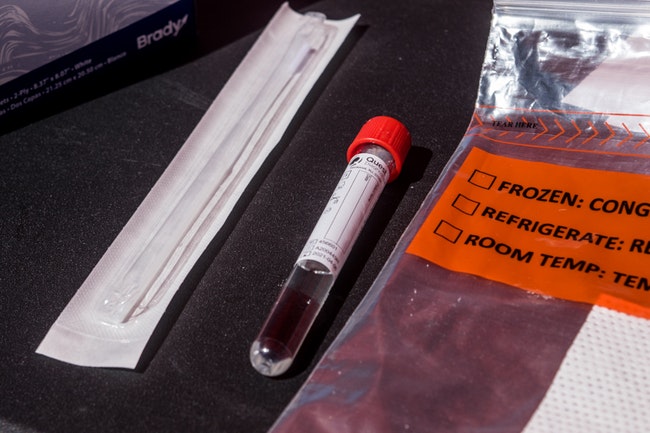
A Covid testing kit at Nyssa drive by testing site earlier this summer. The county’s positive testing rate is high but more testing could potentially push it down. (Kezia Setyawan/The Enterprise)
ONTARIO – The odds of Malheur County coming off a state Covid watch list remain slim as the virus infection rate on a per capita basis spiked to the highest in Oregon last week and health officials concede there are far more cases locally than have been detected through testing.
Malheur County now rates as the worst in the state for coronavirus infections. The state reported that the county infection rate, assessed to furnish comparison to other counties, has hit 3,503 per 100,000 population.
Cases at Snake River Correctional Institution are not helping the county rate.
The prison reported that for last week, 44 inmates were infected, adding to 42 cases the previous week.
The prison cases account for one-third of all the new cases listed by the county last week, which totaled 132. State and county health authorities include the prison cases in reporting Malheur County’s totals, a measure some see as troubling because it appears to distort the severity of the pandemic in the community.
As of Sunday, the Malheur County Health Department reported 1,175 positive Covid tests dating back to the first case in late March. The county has listed 18 deaths from Covid.
Overall Covid cases in the county have leveled off slightly from a high in mid-July but it is the area’s weekly Covid positive rate that unsettles health officials.
The rate measures the percentage of people tested for the virus who are determined to be infected. The weekly positive rate for the county was 44.8%. The state rate was 4.1%.
The county weekly positive rate is also way above the mark – a 5% positive rate – that would allow schools to resume classroom instruction.
Sporadic spread of the virus continues, said Sarah Poe, Malheur County Health Department director. Sporadic spread indicates the extent of the virus in the county.
“It tells us that a person was likely infected by someone who didn’t even know was sick because we can’t trace it back to a case. The sporadic spread really points to how much worse the situation is than we know,” said Poe.
Poe said the Covid outbreak in the county is a multi-tiered problem. For example, if the prison case numbers were lifted out of the total county count – as has been done in other Oregon counties – then the local positive rate would drop.
“It could make a big difference. Right now, overall, they make up between 22 and 25 percent of our cases,” said Poe.
Another way to get the positive rate down is through more testing of people who have so far not received a Covid test.
“We really need considerably more testing of new people,” said Poe.
A limit on Covid tests has hampered efforts by local health officials to stamp out Covid since the beginning of the epidemic.
“Testing availability has been a huge part of it,” said Poe.
Poe said overall Oregon continues to report a moderate infection rate, which hurts efforts to get more testing supplies.
“Because Oregon numbers have been so good as a state, in flattening the curve compared to other spots, Oregon has not been the highest priority nationwide for testing capacity,” said Poe.
Poe said the testing shortage is a “national supply chain issue.”
“We’ve advocated with our representatives nationally that they need to be advocating for Oregon to get more tests,” said Poe. “It’s not like other states have tests we don’t have access to.”
Poe said there is some good news regarding testing capacity on the horizon.
“The FDA did recently approve a saliva rapid test. It is not very sensitive and is meant to be performed more regularly. We are hoping that becomes available,” said Poe. Poe also said the county is contracting with the state to get another new self-swab test with a new lab.
“That is potentially coming and would be available for us for surveillance testing,” said Poe.
Testing by the health department did drop off last week – to under 300 a week – and Poe said there are several reasons for that.
“Perhaps people are experiencing less symptoms. There could also be some hesitation to testing or misunderstanding. And we didn’t do drive-up testing last week,” said Poe.
Accurate data regarding Covid hospitalizations also was missing last week and Poe said that is because of confusion with hospitals in the Treasure Valley.
“Boise-area hospitals were likely reporting to Idaho health departments but they need to be reporting to health departments where the person resides. It seems like it is taking time to get that procedure fixed,” said Poe.
Also, gaps in reporting hospitalizations occur because “people can be in and out of a hospital. They might be admitted and discharged in the same day.”
“So, we have, absolutely, some gaps in reporting,” said Poe.
Reporter Aidan McGloin also contributed to this report.
News tip? Contact reporter Pat Caldwell at [email protected] or 541-235-1003.
YOU CAN HELP KEEP LOCAL NEWS FLOWING: Reader support allows the Enterprise to provide in-depth, accurate reporting that otherwise would not get done. Keeping the community well informed is essential. SUBSCRIBE – $5 a month, automatically. DONATE – to provide additional support.




